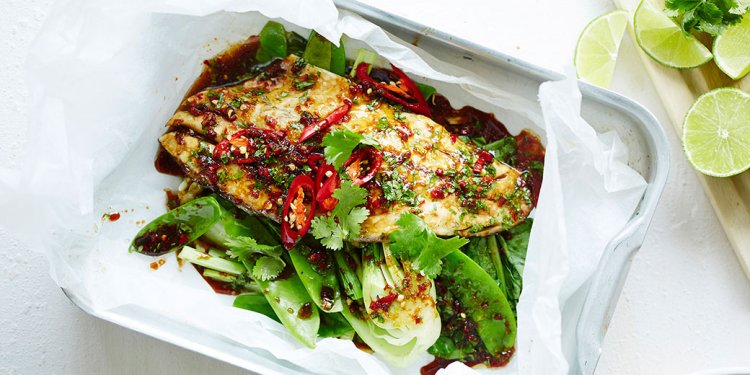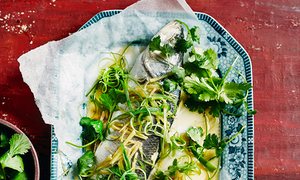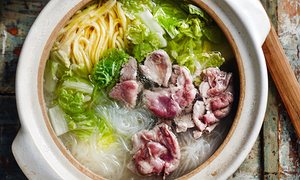
Chinese Style fish Recipes
 Ken Hom’s steamed fish Cantonese style. Photograph: Martin Poole for the Observer
Ken Hom’s steamed fish Cantonese style. Photograph: Martin Poole for the Observer
Ken Hom’s steamed fish Cantonese style
Steaming fish is a great southern Chinese tradition, and it is my favourite method of cooking fish. Nothing masks the fresh taste of the fish, which remains moist and tender at the same time, and you can savour the combination of the other ingredients.
Serves 4
firm white fish fillets 450g, such as seabass or cod, or a whole fish such as turbot
coarse sea salt or plain salt 1 tsp
fresh ginger 1½ tbsp, finely shredded
spring onions 3 tbsp, finely shredded
light soy sauce 1 tbsp
dark soy sauce 2 tsp
groundnut or vegetable oil 1 tbsp
sesame oil 2 tsp
fresh coriander sprigs, to garnish
If you are using a whole fish, remove the gills. Pat the fish or fish fillets dry with kitchen paper. Rub with the salt on both sides, then set aside for 30 minutes. This helps the flesh to firm up and draws out any excess moisture.
 Next set up a steamer, or put a rack into a wok or deep pan, and fill it with 5cm (2in) of water. Bring the water to the boil over a high heat. Put the fish on a heatproof plate and scatter the ginger evenly over the top. Lower the plate of fish into the steamer or on to the rack. Cover the pan tightly and gently steam the fish until it is just cooked. Flat fish will take about 5 minutes to cook. Thicker fish will take 12-14 minutes.
Next set up a steamer, or put a rack into a wok or deep pan, and fill it with 5cm (2in) of water. Bring the water to the boil over a high heat. Put the fish on a heatproof plate and scatter the ginger evenly over the top. Lower the plate of fish into the steamer or on to the rack. Cover the pan tightly and gently steam the fish until it is just cooked. Flat fish will take about 5 minutes to cook. Thicker fish will take 12-14 minutes.
Remove the plate of cooked fish from the pan and sprinkle with the spring onions and the light and dark soy sauces. Heat the two oils together in a small pan. When they are hot and smoking, pour the hot oil on top of the fish and garnish with the coriander sprigs. Serve at once.
 Jihua Li’s home style cabbage
Jihua Li’s home style cabbage
Photograph: Martin Poole for the Observer
Serves 1
vegetable or olive oil
Sichuan peppercorns 2 tsp
garlic 2-3 cloves, minced or sliced
spring onion 1, chopped
dried chilli 3-4, crumbled or cut into small pieces
green chilli to taste
sweetheart cabbage ½, torn or cut into 5-7cm pieces
soy sauce 2 tsp
sugar 1 tsp
Put 3-4 teaspoons of vegetable or olive oil in the wok, heat with max power. Put the Sichuan peppercorns into the wok. Leave it for half a minute or until the peppercorns turn dark, use a strainer or skimmer to remove the Sichuan peppercorns.
Add the garlic, spring onion, dried chilli and green chilli, stir fry for a few seconds and then add in the cabbage pieces. Stir fry until it becomes tender.
Add the soy sauce and sugar. Continue to stir fry for 20 seconds or so. The dish is now ready!
Silk Road, 49 Camberwell Church Street, London SE5 8TR; 020 7703 4832
 Yan-kit So’s Mongolian lamb fire pot
Yan-kit So’s Mongolian lamb fire pot
Photograph: Martin Poole for the Observer
This Mongolian dish, which has long since become part and parcel of Peking food, ranks second in fame only to the Peking duck.
Serves 6 as dinner
lamb ½ leg, ideally spring lamb, about 1.2kg
cellophane noodles 100g
Chinese celery cabbage 1, about 800g, trimmed
dried egg or buckwheat noodles 225g
For the dip
sesame paste 120ml, well stirred in the jar
fermented red bean curd 2 cakes, or about 4 tbsp plus 2 tbsp own juice
Shaoxing rice wine or medium dry sherry 90ml
sugar 3 tbsp
thin soy sauce 120ml
hot chilli oil 3-4 tbsp
sesame oil 3-4 tbsp
fish sauce 4 tbsp
coriander leaves 100g, chopped into small pieces
spring onions 10-12 large, cut into small rounds
Ask the butcher to bone the lamb for you. If possible, freeze for about 3-4 hours so that the meat becomes firm and easy to cut into paper-thin slices.
Meanwhile, soak the cellophane noodles in plenty of boiling water in a bowl. Leave for a minimum of 20-30 minutes to expand. Drain. Make 2-3 cuts with scissors to shorten them. Transfer to a serving bowl.
Slice the celery cabbage at 2.5cm intervals. Put on to a plate.
Plunge the noodles into plenty of boiling water, return to the boil, then continue to cook for several minutes until they are soft yet al dente. Drain and rinse under cold running water. Put on to a plate or into a bowl.





















